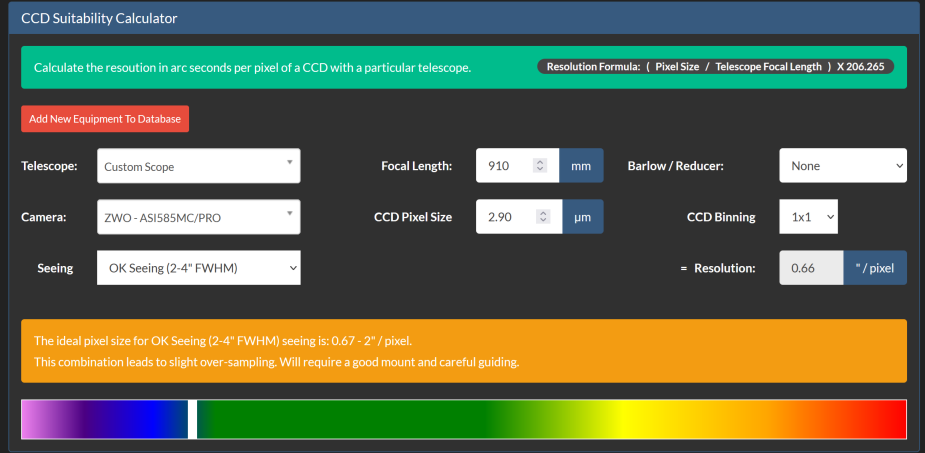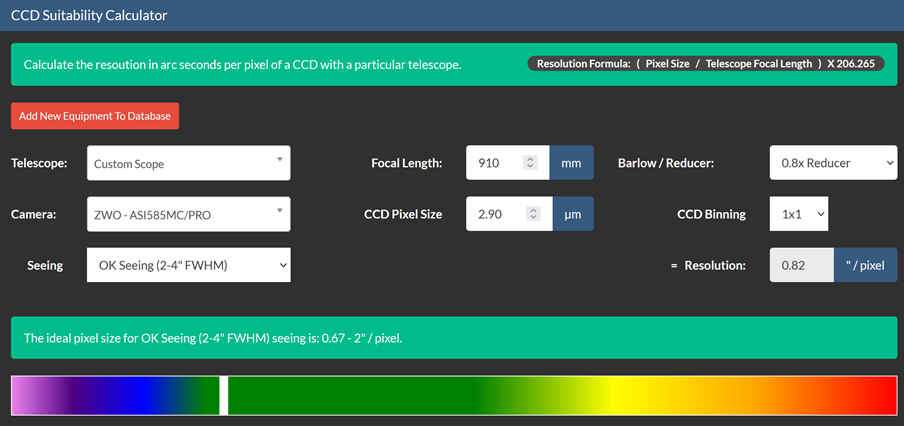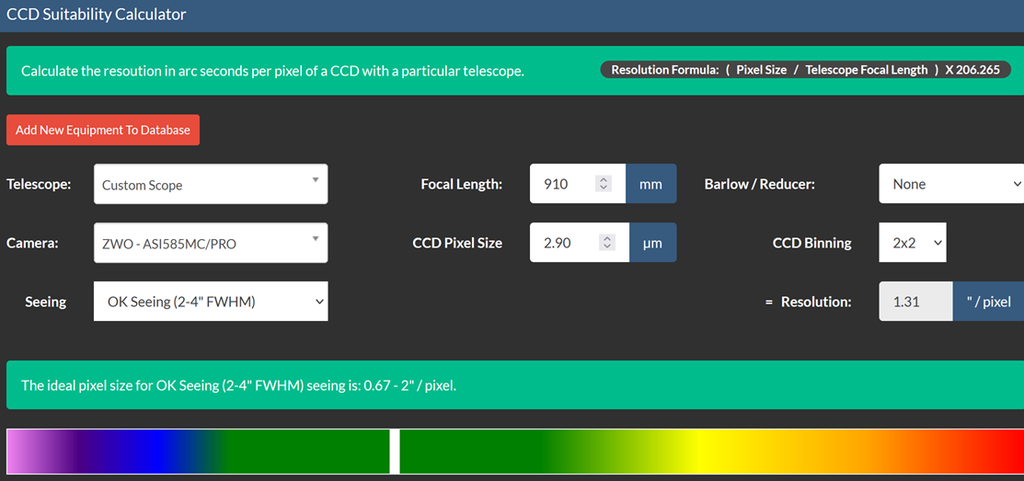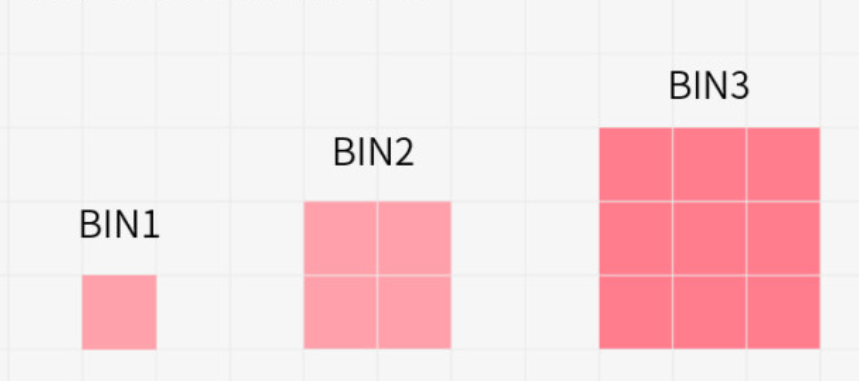I haven't had time to try it myself but I'm curious, would there be any benefit to running a guide scope with a 2X barlow. In my case, guiding at 800mm verses 400mm. My guide cam pixel size is already rather small at 2.9 microns.
|
You cannot like this item. Reason: "ANONYMOUS".
You cannot remove your like from this item.
Editing a post is only allowed within 24 hours after creating it.
You cannot Like this post because the topic is closed.
Copy the URL below to share a direct link to this post.
This post cannot be edited using the classic forums editor.
To edit this post, please enable the "New forums experience" in your settings.
Negative. Light sensibility and drowning the noise with signal is far more important than getting past the 400mm focal length, which is already a pretty large focal for a guide scope. On top of significantly decreasing the signal, the barlow may introduce aberration, make stars no longer round & more.
There's a reason the 5.86um pixel size ASI174MM camera is considered good for guiding.
|
You cannot like this item. Reason: "ANONYMOUS".
You cannot remove your like from this item.
Editing a post is only allowed within 24 hours after creating it.
You cannot Like this post because the topic is closed.
Copy the URL below to share a direct link to this post.
This post cannot be edited using the classic forums editor.
To edit this post, please enable the "New forums experience" in your settings.
mmmmm, I really can't see a barlow doing any of those things with a point source. I don't have any problems at 2.9mc so I'm not sure that larger pixels would be an advantage. I'm just going to have to give it a try.
|
You cannot like this item. Reason: "ANONYMOUS".
You cannot remove your like from this item.
Editing a post is only allowed within 24 hours after creating it.
You cannot Like this post because the topic is closed.
Copy the URL below to share a direct link to this post.
This post cannot be edited using the classic forums editor.
To edit this post, please enable the "New forums experience" in your settings.
Tony Gondola:
mmmmm, I really can't see a barlow doing any of those things with a point source. I don't have any problems at 2.9mc so I'm not sure that larger pixels would be an advantage. I'm just going to have to give it a try. No one will stop you from trying it. However, it is not an opinion that the barlow will significantly reduce the light signal by increasing the F stop. This is how optic work. The rest is up to the glass quality. The appreciation for large pixel size cameras for guiding is again a matter of light gathering power, giving PHD2 less margin of error in term of noise/signal ratio. You can read up on subpixel sampling to understand why PHD2 can work with guide scopes of significantly shorter focal length than the main scope.
|
You cannot like this item. Reason: "ANONYMOUS".
You cannot remove your like from this item.
Editing a post is only allowed within 24 hours after creating it.
You cannot Like this post because the topic is closed.
Copy the URL below to share a direct link to this post.
This post cannot be edited using the classic forums editor.
To edit this post, please enable the "New forums experience" in your settings.
The question is why would you want to?
Typical recommendation is that the image scale on the guider should be no more than 10X larger than the main camera. I think 5X is more than enough. So assuming the pixel sizes are the same on guide camera and imaging camera, a 300mm FL guidescope would be fine guiding a 1500mm OTA.
The star profiles use a centroid calculation that is much finer than the size of the pixel.
I would also argue that any time you have an OTA long enough guidescope image scale to be of concern that you should consider and OAG instead.
Kevin
|
You cannot like this item. Reason: "ANONYMOUS".
You cannot remove your like from this item.
Editing a post is only allowed within 24 hours after creating it.
You cannot Like this post because the topic is closed.
Copy the URL below to share a direct link to this post.
This post cannot be edited using the classic forums editor.
To edit this post, please enable the "New forums experience" in your settings.
If anything it will make your guiding worse, at the moment you are already guiding at a fairly aggressive 1.5''/px which is good enough for practically any situation with any scope. Adding a barlow cut your signal to noise ratio in half, and probably not add any more actual resolution to your guide system and instead just make things worse. Maybe some 2000mm+ focal length scope on a Chilean mountain would benefit from more resolution, but i am assuming you dont use one.
Also you dont mention what type of guide scope you are using. Is it an 80mm f/5 achromat perhaps? If so, your 1.5''/px is already too much and there is practically no chance you would benefit from higher guide resolution. If anything you might benefit from binning your guide cam x2.
For comparison i am guiding at a resolution of 1.4''/px with a 10'' scope and an OAG at the moment, and there is more than enough resolution to work with. I think i could bin x3 and still see no adverse effects, but no reason to as the 220MM i am using has excellent signal to noise ratio already.
|
You cannot like this item. Reason: "ANONYMOUS".
You cannot remove your like from this item.
Editing a post is only allowed within 24 hours after creating it.
You cannot Like this post because the topic is closed.
Copy the URL below to share a direct link to this post.
This post cannot be edited using the classic forums editor.
To edit this post, please enable the "New forums experience" in your settings.
Yes, I am guiding with the 80mm and both cameras have the same pixel size. I'm happy with my guiding but of course, I'm always looking for refinements. Sounds like I really can't improve on what I have so moving on. I will try binning though, interesting idea.
|
You cannot like this item. Reason: "ANONYMOUS".
You cannot remove your like from this item.
Editing a post is only allowed within 24 hours after creating it.
You cannot Like this post because the topic is closed.
Copy the URL below to share a direct link to this post.
This post cannot be edited using the classic forums editor.
To edit this post, please enable the "New forums experience" in your settings.
Hi Tony, I performed that test and you can improve the guidance, but by reducing the luminosity in the guidance tube you need a camera that has a high gain.
In my case it worked well with the ASI174mm, but with the Asi 120mm I couldn't get any stars to guide. From my point of view, putting the Barlow in the guide tube can be more harmful than beneficial and if you currently get good guidance it is not necessary, but I will gladly share my impressions with you.
Can you share the focal length of the main telescope and the RMS you obtain when guiding with 80 and 400 mm?
It is also important to know what guidance camera you have, to see what gain it can work with.
|
You cannot like this item. Reason: "ANONYMOUS".
You cannot remove your like from this item.
Editing a post is only allowed within 24 hours after creating it.
You cannot Like this post because the topic is closed.
Copy the URL below to share a direct link to this post.
This post cannot be edited using the classic forums editor.
To edit this post, please enable the "New forums experience" in your settings.
Sure, the main scope is a 90mm working at an EFL of 910mm. The guide scope is an 80mm F/5 working at 400mm. Both main and guide cameras are ZWO585 based, the main camera is the cooled version. Typically I see between 0.6" and 0.5" RMS guiding error.
|
You cannot like this item. Reason: "ANONYMOUS".
You cannot remove your like from this item.
Editing a post is only allowed within 24 hours after creating it.
You cannot Like this post because the topic is closed.
Copy the URL below to share a direct link to this post.
This post cannot be edited using the classic forums editor.
To edit this post, please enable the "New forums experience" in your settings.
Hi Tony. With a focal length of 910 mm, 2.9 microns and a resolution of 0.5 to 0.6" it is perfect, you don't need better guidance. Let me send you a link that does the calculations for you: https://astronomy.tools/calculators/ccd_suitability
 =Y2IQFchis tells you that for your focal length and This tells you that your pixel size, you need a minimum resolution of 0.66". Since your RMS, which is the resolution you have in the guide, is 0.5 to 0.6" you are fine. If you would like to work with more guidance margin, instead of increasing the focal length of the guiding tube with a Barlow, I recommend using BIN2x2 or using a focal reducer, which on the other hand will save you a lot of time since you are working with an f/10 focal length. which is very high. I give you two examples, one using a 0.8x reducer and another with 2x2 BIN.  With a 0.8x reducer, the minimum resolution you should have is 0.82, which gives you more margin for error.  Using the BIN2x2, you have even greater margin, with the minimum resolution being 1.31"/pixel. Try it.
|
You cannot like this item. Reason: "ANONYMOUS".
You cannot remove your like from this item.
Editing a post is only allowed within 24 hours after creating it.
You cannot Like this post because the topic is closed.
Copy the URL below to share a direct link to this post.
This post cannot be edited using the classic forums editor.
To edit this post, please enable the "New forums experience" in your settings.
I do not think your idea will improve your guiding as it seems you are well between the (soft) limits with your native focal length.
I in fact suspect that an barlow-configuration may decrease your guiding accuracy a bit.
But it could be a fun experiment and please report your results if you go thru with it.
|
You cannot like this item. Reason: "ANONYMOUS".
You cannot remove your like from this item.
Editing a post is only allowed within 24 hours after creating it.
You cannot Like this post because the topic is closed.
Copy the URL below to share a direct link to this post.
This post cannot be edited using the classic forums editor.
To edit this post, please enable the "New forums experience" in your settings.
While I'm also on the boat of (I dont think it'll actually help based on the the calculations) you should totally try and it and let us know. I'm all for testing/pushing what our common understanding currently is.
A lot of the best discoveries come out of testing actions that shouldn't work better. Most of the time, they don't, and we solidify our knowledge. Sometimes they do, and then we have to figure it out.
Ideally, you can rule out as many variables as possible and introduce the barlow for part of the evening and compare results? Looking forward to hearing about it!
|
You cannot like this item. Reason: "ANONYMOUS".
You cannot remove your like from this item.
Editing a post is only allowed within 24 hours after creating it.
You cannot Like this post because the topic is closed.
Copy the URL below to share a direct link to this post.
This post cannot be edited using the classic forums editor.
To edit this post, please enable the "New forums experience" in your settings.
I get better guiding when I bin my guide camera 2x2.. my guider is an imx178, which, in the oag on my 120mm f7 apo, is 0.59"/px. My imaging camera is an imx 294 at 1.14"/px.
when I bin 2x2, I'm effectively guiding at 1.18"/px, and the results are sub 0.5" corrections. Where as I found when I was guiding bin 1x1, my guide corrections rms value was 0.9-1.1, I always put this down to seeing while grossly oversampling..
|
You cannot like this item. Reason: "ANONYMOUS".
You cannot remove your like from this item.
Editing a post is only allowed within 24 hours after creating it.
You cannot Like this post because the topic is closed.
Copy the URL below to share a direct link to this post.
This post cannot be edited using the classic forums editor.
To edit this post, please enable the "New forums experience" in your settings.
Leonardo Ruiz:
Hi Tony.
With a focal length of 910 mm, 2.9 microns and a resolution of 0.5 to 0.6" it is perfect, you don't need better guidance.
Let me send you a link that does the calculations for you:
https://astronomy.tools/calculators/ccd_suitability
 =Y2IQFchis tells you that for your focal length and =Y2IQFchis tells you that for your focal length and
This tells you that your pixel size, you need a minimum resolution of 0.66". Since your RMS, which is the resolution you have in the guide, is 0.5 to 0.6" you are fine.
If you would like to work with more guidance margin, instead of increasing the focal length of the guiding tube with a Barlow, I recommend using BIN2x2 or using a focal reducer, which on the other hand will save you a lot of time since you are working with an f/10 focal length. which is very high.
I give you two examples, one using a 0.8x reducer and another with 2x2 BIN.

With a 0.8x reducer, the minimum resolution you should have is 0.82, which gives you more margin for error.

Using the BIN2x2, you have even greater margin, with the minimum resolution being 1.31"/pixel.
Try it. That's very helpful so thank you for that. I'll give 2x2 binning a try for the next session.
|
You cannot like this item. Reason: "ANONYMOUS".
You cannot remove your like from this item.
Editing a post is only allowed within 24 hours after creating it.
You cannot Like this post because the topic is closed.
Copy the URL below to share a direct link to this post.
This post cannot be edited using the classic forums editor.
To edit this post, please enable the "New forums experience" in your settings.
When you take photos in bin1 you take photos with the native resolution of your sensor. Each pixel acts as a pixel. When you take photos in bin2, you use 2x2 pixels to form a new ,4 pixel, pixel . You will have a pixel 4 times the surface area of the native pixel, with 4 times more light collection capacity. In your case, with an f/10 focal length you will notice that you capture more light, as if you had increased the exposure time. On the other hand, what you will notice when combining 2x2 is that the resolution of your camera is reduced to a quarter, since you effectively have 4 times fewer pixels. But this also doubles the signal-to-noise ratio.  |
You cannot like this item. Reason: "ANONYMOUS".
You cannot remove your like from this item.
Editing a post is only allowed within 24 hours after creating it.
You cannot Like this post because the topic is closed.
Copy the URL below to share a direct link to this post.
This post cannot be edited using the classic forums editor.
To edit this post, please enable the "New forums experience" in your settings.
Tony Gondola:
I can give you my experience, I have a GSO RC8 and an Ioptron GEM45 + asi294mc pro, due to weight issue I could not fit a 600mm guide tube for guiding and without an OAG it is difficult to guide, but i did the test with my william optic uniguide 50/200mm f4 with a barlow x2 and the asi120mm + uhc filter (because i am in a bortle scale 9 sky), the RC8 is f8 and the guiding was at f8 the same (because of the barlow), in astronomy-tools it gave me a ratio of 1:3.29, in real life, everything worked perfectly, I had visible stars and maintained the usability ratio of the guidance (maximum 1/3 of the focal length of the main) allowed me to play for a long time and did not exceed the 13kg of the mount for proper guidance. |
You cannot like this item. Reason: "ANONYMOUS".
You cannot remove your like from this item.
Editing a post is only allowed within 24 hours after creating it.
You cannot Like this post because the topic is closed.
Copy the URL below to share a direct link to this post.
This post cannot be edited using the classic forums editor.
To edit this post, please enable the "New forums experience" in your settings.
Rodrigo Flores:
Tony Gondola:
I can give you my experience, I have a GSO RC8 and an Ioptron GEM45 + asi294mc pro, due to weight issue I could not fit a 600mm guide tube for guiding and without an OAG it is difficult to guide, but i did the test with my william optic uniguide 50/200mm f4 with a barlow x2 and the asi120mm + uhc filter (because i am in a bortle scale 9 sky), the RC8 is f8 and the guiding was at f8 the same (because of the barlow), in astronomy-tools it gave me a ratio of 1:3.29, in real life, everything worked perfectly, I had visible stars and maintained the usability ratio of the guidance (maximum 1/3 of the focal length of the main) allowed me to play for a long time and did not exceed the 13kg of the mount for proper guidance That's an interesting real-world example so thank you for that. I usually image at 900mm and guide at 400mm but I have a session coming up where the 400mm will be the primary imager so I'll guide using the 900mm. I'll be looking closely at how that combination behaves.
|
You cannot like this item. Reason: "ANONYMOUS".
You cannot remove your like from this item.
Editing a post is only allowed within 24 hours after creating it.
You cannot Like this post because the topic is closed.
Copy the URL below to share a direct link to this post.
This post cannot be edited using the classic forums editor.
To edit this post, please enable the "New forums experience" in your settings.
Miguel T.:
make stars no longer round & more. This is not important for guide scope. Guide software use mathematics to calculate center of the star even if it is nod round/elongated/etc I use off-axis guider and stars nether round there, because it takes side part of the image from main scope.
|
You cannot like this item. Reason: "ANONYMOUS".
You cannot remove your like from this item.
Editing a post is only allowed within 24 hours after creating it.
You cannot Like this post because the topic is closed.
Copy the URL below to share a direct link to this post.
This post cannot be edited using the classic forums editor.
To edit this post, please enable the "New forums experience" in your settings.
Andrii Aloshyn:
Miguel T.:
make stars no longer round & more.
This is not important for guide scope. Guide software use mathematics to calculate center of the star even if it is nod round/elongated/etc
I use off-axis guider and stars nether round there, because it takes side part of the image from main scope. I use a OAG too and stars are not perfectly round but you underestimate what a barlow can do to your optic, especially on small diameter ones. You'll see what I mean when you'll exceed the power of your scope/guidescope with a barlow in front of a tiny pixel planetary camera and destroy stars so much that they are no longer recognized making autofocus/platesolve impossible.
|
You cannot like this item. Reason: "ANONYMOUS".
You cannot remove your like from this item.
Editing a post is only allowed within 24 hours after creating it.
You cannot Like this post because the topic is closed.
Copy the URL below to share a direct link to this post.
This post cannot be edited using the classic forums editor.
To edit this post, please enable the "New forums experience" in your settings.
Just to put a stopper on this question. I haven't had a chance to try a 2x barlow on my guide scope but I did have an opportunity to switch up my system. To do a mosaic of M31, I imaged through my 80mm F.5 guide scope and guided through the 150mm F/6 main scope. After proper calibration, I observed that my guiding accuracy (at least as reported by PHD2) was about the same at 900mm as it was at 400mm. In fact in might have been a bit worse. I would put that down to the larger aperture being more affected by the seeing which was pretty rough last night.
|
You cannot like this item. Reason: "ANONYMOUS".
You cannot remove your like from this item.
Editing a post is only allowed within 24 hours after creating it.
You cannot Like this post because the topic is closed.
Copy the URL below to share a direct link to this post.
This post cannot be edited using the classic forums editor.
To edit this post, please enable the "New forums experience" in your settings.






